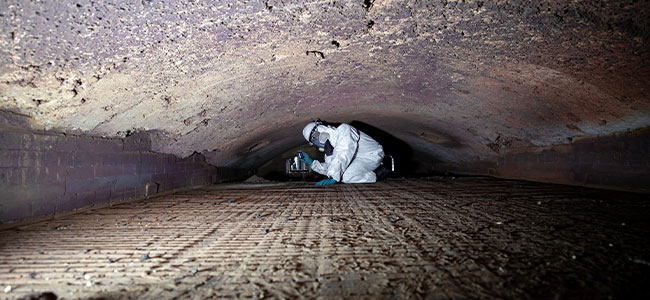
Training Is Essential to Prevent Fatalities in Confined Spaces
Confined spaces safety training involves multiple critical elements to prevent accidents and safeguard the lives of workers in high-risk environments.
- By Ralph Blessing
- May 01, 2024
The word “confined” can generate fear in many. According to OSHA, a confined space is one that has limited ingress and egress, is not meant for continued occupancy and is large enough for an employee to enter and conduct work (OSHA, 2024).
A confined space can be unforgiving in many ways. The Bureau of Labor Statistics reported in 2020 that 1039 employees died due to this issue between 2011 and 2018 (BLS, 2020). These were senseless losses that clearly could have been averted by simply following the guidelines established in 29CFR1910.147 and/or 29CFR1926.1200.
To prevent these types of deaths, proper training is essential to ensure workers can identify hazards, utilize necessary equipment, and respond effectively to emergencies.
The Dangers of Confined Spaces
The following examines the training requirements for confined space entry, highlighting key elements such as hazard recognition, atmospheric monitoring, and emergency procedures. By understanding and fulfilling these requirements, organizations can mitigate risks and prioritize the safety of workers in confined spaces.
The first and most important aspect of confined space training is identifying what is a confined space based on the three factors mentioned earlier. Once this has been established, it is incumbent upon the employer to identify if there are any other confinement hazards such as engulfment, low oxygen levels, explosive atmosphere, electrical or caught-between (when a worker can be compressed between two objects or can caught in equipment). If any of these situations exist, then the confined space now becomes a permit-required confined space (PRCS), requiring a lot more scrutiny and action on the part of the employer.
Before entering a non-permit or PRCS space, efforts should be made to purge the space to ensure any hazardous gases or other hazardous atmosphere(s) are cleared, employing the required calculations. This involves measuring the total cubic feet of the space and identifying the capacity of the purging fan. Fans will have their capacity indicated on their information plates and it is identified in cubic feet per minute (CFM). Although OSHA does not specifically identify how many exchanges need to occur, a good rule of thumb is five complete air exchanges before retesting the space and entering. The goal is to maintain an oxygen level between 19.5 and 23.5 percent.
Test the confined space for gases at the spacing intervals (stratified) recommended by the manufacturer of the gas detector. This may require vertical and horizontal testing, depending on the configuration of the space since different gases may be present at different levels. Retesting of the atmosphere is always required after the original purge when a toxic gas was encountered.
It is highly recommended that continuous ventilation be employed since the atmosphere may change without notice due to the type of work taking place. This work could include something as simple as welding or employing a chemical for cleaning.
Consider Checklist Before Entering
If a permit needs to be issued, it must contain specific information before entry can be made. It must have:
• The space to be entered. The purpose of the entry.
• The date and the authorized duration of the permit. OSHA does not indicate exact times that a permit is approved.
• The authorized entrants.
• Personnel listed serving as attendants.
• Entry supervisor.
• Any hazards in the space.
• Measures used to isolate the space and abate or eliminate the hazards.
• Acceptable entry conditions.
• Results of initial tests and any follow-on testing that should be accomplished every 15 minutes.
• Rescue services.
• Communication procedures.
• Equipment (PPE, meters, fans, communications, rescue) which is being utilized.
• Any other permits including hot work (electrical or gas welding), lockout/tagout to authorize work in the space.
Employees authorized to perform permit-required confined space entry must be trained before they are assigned entry duties.
Levels of Training for Company Workers
Employees who are responsible for the overall operation (supervisor) must be trained to:
• Determine if space can be entered safely.
• Ensure logs are maintained as required to monitor oxygen levels and any hazardous atmospheres that could find their way into the space.
• Terminate the entry and cancel the permit once all personnel have been removed and the space has been closed.
Employees who work in confined spaces (entrants) must be trained to:
• Alert attendants about hazards.
• Understand warning signs.
• Use suitable personal protective equipment (PPE).
Employees who assist entrants from outside the confined space (attendants) must be trained to:
• Determine hazards.
• Monitor work conditions.
• Coordinate resources.
• Maintain worker count.
• Communicate with entrants.
• Allow only qualified and authorized entrants to enter the space.
Should an incident occur, it is incumbent upon the contractor(s) making the entry to have rescue and emergency services available. This rescue could include the use of a tripod and winch which would be operated by the attendant or other personnel, or a rescue team or service.
The bottom line is that any time a limit is exceeded, no matter what the reason, all personnel shall immediately exit the space, and no others shall enter until atmospheric conditions are returned to safe levels.
Remember that OSHA standards address confined spaces in specific regulations for general industry, maritime, and construction. Safety training is crucial to prevent accidents and protect the lives of workers in confined spaces.
This article originally appeared in the April/May 2024 issue of Occupational Health & Safety.